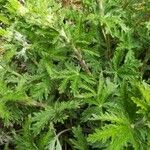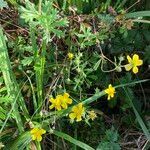Herbs perennial. Roots robust, terete. Flowering stems erect or ascending, 12–40 cm tall, together with petioles villous, pubescent, and sparsely tomentose. Radical leaves usually withered after anthesis; stipules brown, membranous, abaxially villous; leaf blade palmately 5(–7)-foliolate; leaflets adaxially green, obovate-oblong or obovate-lanceolate, abaxially canescent tomentose, glabrescent, adaxially appressed pilose, base cuneate, margin coarsely regularly serrate, apex obtuse; cauline leaves resembling radical ones but smaller and petiole shorter to absent; stipules green, ovate-lanceolate, herbaceous, abaxially tomentose and villous, margin entire or 1-or 2-serrate. Inflorescence corymbose-cymose or paniculate-cymose, laxly many flowered. Flowers ca. 1 cm in diam.; pedicel 1–1.5 cm, sparsely tomentose and villous. Sepals triangular-lanceolate to oblong-ovate, apex acute to acuminate; epicalyx segments linear-lanceolate, shorter than or rarely nearly equaling sepals, abaxially villous and pubescent, apex acute. Petals yellow, ovate, slightly longer than sepals, apex emarginate or subrounded. Style subterminal, base thickened; stigma slightly thickened. Achenes rugose. Fl. and fr. Jun–Sep.
(P. canescens), a European sp. rarely intr. in our range, differs from P. argentea most notably in having some long, spreading, simple hairs on the stem, and also some long, simple hairs on the lf-veins beneath, in addition to the tomentum.




